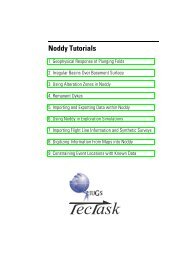Revised Eburnean geodynamic evolution of the ... - Tectonique.net
Revised Eburnean geodynamic evolution of the ... - Tectonique.net
Revised Eburnean geodynamic evolution of the ... - Tectonique.net
Create successful ePaper yourself
Turn your PDF publications into a flip-book with our unique Google optimized e-Paper software.
S. Perrouty et al. / Precambrian Research 204– 205 (2012) 12– 39 33<br />
Fig. 14. Detailed comparison <strong>of</strong> radiometric (over HH radar polarisation) and mag<strong>net</strong>ic data (RTP, first vertical derivative after automatic gain control). The mag<strong>net</strong>ic trends<br />
do not correlate with bedding (S0) or S3 orientations observed in <strong>the</strong> Tarkwa Group that are well imaged in <strong>the</strong> radiometric data. These trends may correspond to older Sefwi<br />
Group lineaments (related to D1) beneath <strong>the</strong> Tarkwaian sediments. See Fig. 1 for location.<br />
Fig. 15. Test <strong>of</strong> susceptibility impact <strong>of</strong> deep units on mag<strong>net</strong>ic RTP image. These tests were conducted using Noddy s<strong>of</strong>tware assuming a 3000 m maximum depth for <strong>the</strong><br />
Tarkwa Basin with various susceptibility contrasts between <strong>the</strong> Sefwi Group (BS) and <strong>the</strong> Tarkwa Group (TS) susceptibilities. We note that <strong>the</strong> Sefwi Group structures (folds<br />
in this example) are imaged beneath <strong>the</strong> Tarkwa Basin when <strong>the</strong> Sefwi Group is at least 5 times more susceptible than <strong>the</strong> overlying Tarkwa Basin.




